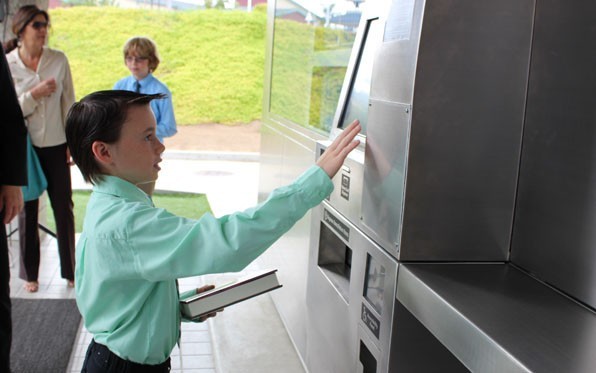Daily Business Report-June 24, 2015
Artist’s rendering of Cisterra Development’s proposed building project at Seventh Avenue and Market Street in Downtown San Diego — one of two Downtown projects recommended for approval by a selection committee of Civic San Diego.
Cisterra Seeks Approval For Large-Scale
Residential, Retail and Hotel Project Downtown

A Civic San Diego selection committee is backing a proposal by Cisterra Development to build a 751,500-square-foot project at Seventh Avenue and Market Street in Downtown that would include for-sale condominiums, rental apartments, retail stores and a 160-room Ritz Carlton hotel.
The selection committee also is promoting a Holland Partner Group proposal to build a 550,000-square-foot mixed-use development at Park Boulevard and Market Street that would contain 341 apartments, office space and retail space.
The two projects will be publicly discussed at the Civic San Diego Real Estate Budget/Finance and Administration Joint Committee on July 15.
The selection committee is requesting that the Civic San Diego board recommend that the City Council enter into exclusive negotiations with the two developers on the projects.

The Cisterra project features 58 for-sale condos, 115 market-rate apartments, 32 affordable apartments, the Ritz Carlton hotel, 156,000 square feet of office space, 238 public parking spaces and more than 46,000 square feet of retail space, including a gourmet grocer.
Holland Partner Group’s plan includes 341 apartment, 51,700 square feet of office space and 22,900 square feet of retail space.
“The selection committee reviewed and carefully evaluated some exciting proposals and are confident they have identified two highly qualified teams that will deliver innovative place-making projects that provide great amenities and housing for downtown San Diego,” said Civic San Diego president Reese A. Jarrett. “These developments reflect our mission to provide varied housing options for our community with the addition of nearly 100 affordable homes, as well as important revenues earmarked for future development of affordable housing.”
Other development proposals considered by the selection committee for the Seventh Avenue and Market Street site included Douglas Wilson Companies and The Robert Green Co. for the Park Boulevard and Market Street site.

Sunroad Enterprises Begins Phase
4 of Ariva: 300 New Apartments
Sunroad Enterprises, developer of the Centrum Master Plan in central San Diego, has started construction on phase four of Ariva. Phase five of Ariva will break ground in early 2016.
Ariva is part of the Centrum Master Plan, which encompasses four city blocks and features residential, commercial, retail, restaurants, and community green space.
Phase four of Ariva will feature 302 new apartments with rents anticipated to range from $1,700 to $2,500 per month. The new apartment homes will feature similar yet upgraded features and finishes of the existing residences: spacious layouts, quartz countertops, hardwood-style flooring, eco-friendly carpet, and stainless steel and energy-star appliances.
The new phases of Ariva will have an elevated spa and pool, multi-storied fitness facilities, rooftop lounges with built-in barbecues, semi-private social areas with sand fire pits and wooded elevated deck systems, a business center, clubrooms, and game room.
Residents of phase four will also have access to the Ariva Social Club, lounge and spa, concierge, same-day grocery delivery, dry cleaning, and other services. When completed, Ariva will consist of over 800 apartment homes. Ariva was designed by KTGY Architects, with interior design by Catalina Design Group, and is being built by Wermers Construction.
County Moves to Bolster School Safety
The Board of Supervisors unanimously approved a recommendation from Chairman Bill Horn and Supervisor Dianne Jacob on Tuesday to team up with school districts to post Sheriff’s Department and Probation Department officers on many school campuses.
“School safety and keeping kids out of trouble are always critical concerns,” said Jacob. “In this day and age, we need to make sure we’re doing all we can to keep our campuses secure. This initiative also aims to reduce truancies and keep our youth off the streets and in the classroom.”
Sheriff’s Department resource officers would be assigned to as many as 23 high schools, spread over 10 districts. The county hopes to work with the Ramona Unified, Vista Unified, Fallbrook Union and Jamul-Dulzura Union school districts and others.
The county also plans to team up with districts to add probation officers to K-through-8 campuses and other schools to cut truancies. At one time, the county had contracts with eight districts to provide these officers, but many of the contracts were dropped due to a decline in state funding.
County staff was given 90 days to work with the Sheriff’s Department and Probation Department to find ways to put officers in schools.
Adequate Electrical Supplies Available Despite
Drought and High Summer Temperatures
Sufficient electricity supplies are available to meet regional energy needs this summer, though utility customers may be asked to conserve in the event of an unexpected power emergy or the loss of a power plant or transmission line.
That’s the word from San Diego Gas & Electric, the California Independent System Operator Corp. and the California Energy Commission in a joint announcement issued Tuesday.
“The ISO’s recent assessment of summer conditions show we have adequate electricity resources to meet California’s needs this summer, even with the severe drought and high demand expected over this warm summer,” said Steve Berberich, ISO’s president and chief executive officer. “The ISO is committed to a reliable grid, and we will keep a close watch on the system, especially in Southern California where fires, high demand and transmission congestion can present challenges. Consumers also play a vital role in keeping the system reliable by voluntarily conserving power when a Flex Alert is called.”
SDG&E recommends these tips to save on energy use and costs especially during the summer:
• Adjust your thermostat. Set it to 78F for summer AC.
• Use smart strips or unplug items when not in use.
• Replace regular light bulbs with compact fluorescent or LEDs.
• Use motion sensors on outdoor lighting to save up to 50 percent of lighting costs.
• Seal and insulate your home to keep the cool air in during summer.
• Lower your water temperature or try a cold water wash with clothes, especially if you have an electric water heater.
• Change out a single speed pool pump to a variable speed one.

Supervisors Authorize Three
More Library Kiosks in County
Three more Library-to-Go kiosks will be setting up shop in the county over the next several years bringing the county’s total to five, currently more than anywhere else in the country.
The Board of Supervisors voted Tuesday to authorize the purchase of the additional kiosks with the goal of locating one in each supervisorial district.
The first kiosk opened in December 2013 at the County Operations Center in Kearny Mesa and was the first of its kind on the West Coast. A second opened last May at the Bonsall Community Center.
Unlike your typical library, each kiosk is open 24 hours a day, seven days a week yet it still has the full circulation functionality of a library. In other words, customers can browse, check out, return, renew and request materials free of charge.
A 24/7 Library-to-Go kiosk measures 8 feet tall, 13 feet wide and 5 feet deep or about the size of a bus shelter and operates like a vending machine. Each one offers hundreds of the latest books, DVDs and audiobooks on site but customers can gain access to the entire library catalog, including Link+ and Circuit. The mini-library also offers Wi-Fi capability and is ADA accessible.
The kiosks are a great boon to areas that do not have easy access to a county library and are much cheaper than building a full-fledged library. The cost for each new kiosk is about $300,000 versus the millions it would cost for a new facility.
The county is looking at possible sites in Encinitas for one of the new kiosks. Locations for the other two still need to be determined. Elsewhere in the country, two kiosks are located in Oklahoma, one in Milwaukee and one in Fresno.

High School Students Begin Training
For Internships at Biotechnology Firms
Some three dozen high school students from throughout San Diego County have begun an intensive eight-week program that includes hands-on research at The Scripps Research Institute, The Salk Institute and UC San Diego.
The annual Life Science Summer Institute (LSSI) began Monday with Bootcamp, one-week, pre-internship laboratory training program at San Diego Miramar College and Grossmont College in El Cajon. A collaboration between the San Diego Workforce Partnership, the Southern California Biotechnology Center (SCBC) at Miramar College, and BIOCOM, LSSI began in 2005 to strengthen science and math education in San Diego County and inspire more high school students to pursue careers in the region’s burgeoning life sciences industry.
This week’s Bootcamp will give the students 40 hours of lab training so they can immediately contribute once they begin their internship. Among the lessons are learning the correct protocols in preparing solutions, becoming comfortable with laboratory techniques, and understanding the importance of teamwork.
Interns go through an extensive application process, and all must have a minimum grade point average of 3.0 to apply. Students also must craft an essay explaining their interest, solicit two letters of recommendation, and submit a cover letter, resume, and school transcripts. More than 300 students applied for three dozen available internships.
“It’s a very competitive process,” said Dr. Sandra Slivka, who has been the SCBC director since it opened at San Diego Miramar College in 2004. “They’re doing high-level research.”
Memjet to Move to Larger Facilities
Memjet, a provider of color inkjet technology, said it will open a new global headquarters in San Diego to handle its growth.
“Memjet requires a larger facility to increase productivity of its growing employee base of scientists, engineers, technicians and go-to-market experts,” the company said in a release. Housed in a 25,000-square-foot building, the headquarters will combine Memjet’s two previous facilities in San Diego. The space will also include an expansive demo area for new and potential customers, as well as enhanced labs for ink, printhead and hardware innovation.”
“The decision to expand our San Diego footprint was an easy one to make in light of the increased number of employees to support the growing customer base and our continued need to expand our R&D capability across both ink and printhead technology,” said Len Lauer, CEO.



